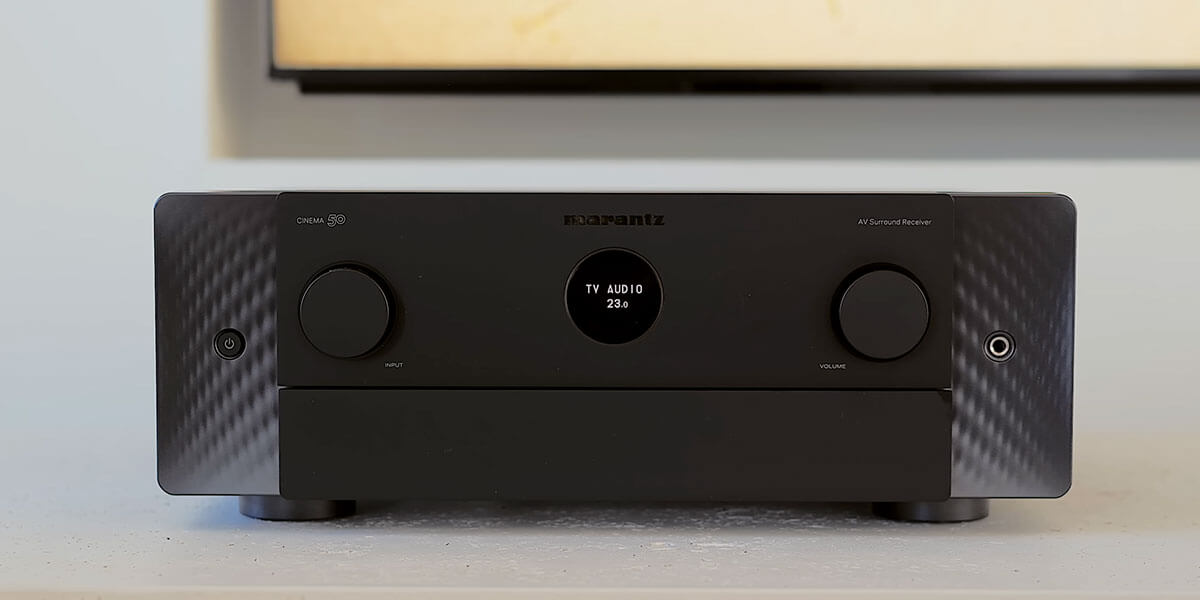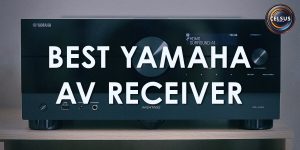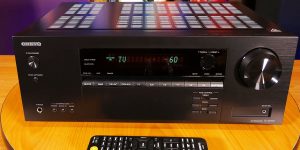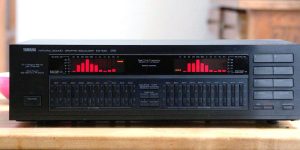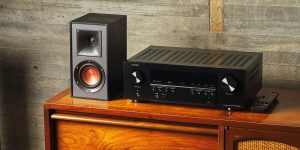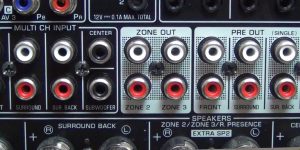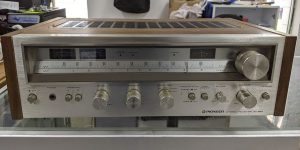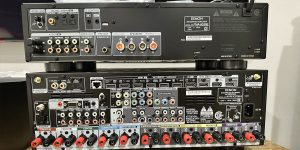Today, I have something very special for you – the best Dolby Atmos receivers. Every unit in today’s review can elevate sound experiences to new heights and bring the magic of three-dimensional audio to the living space.
I split the receivers into different categories to make things even more enjoyable. I bet you will find an interesting model here that suits your needs. So, stay tuned, and let’s explore the world of Atmos-ready receivers.
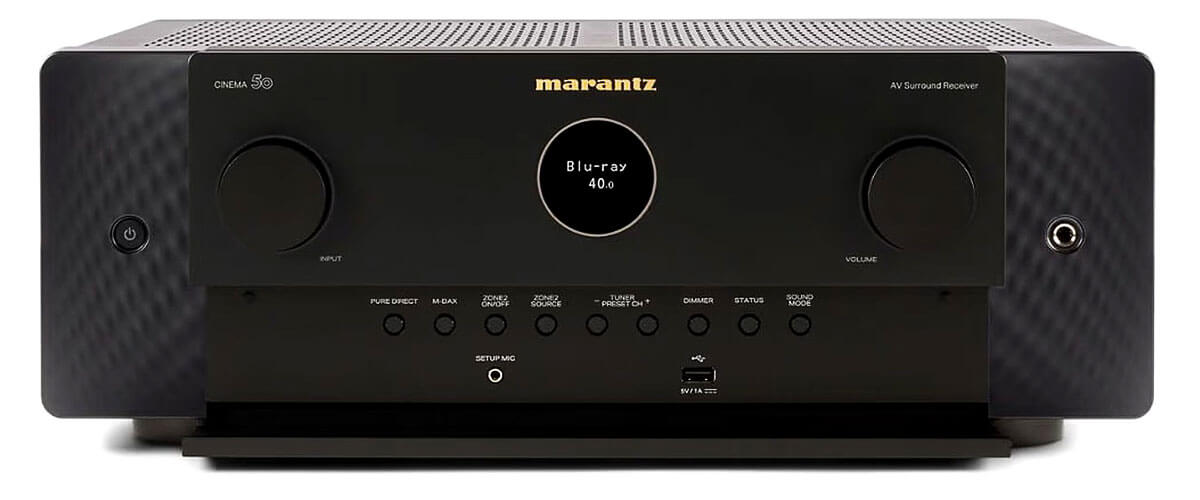
Dolby Atmos receivers comparison table
| Name | Channels | Power output | HDMI in/out | Bluetooth/Wi-Fi | Review |
|---|---|---|---|---|---|
| Marantz Cinema 50 best overall | 9.4 | 110W/8 Ohm, 150W/6 Ohm | 6/2 | yes/yes | Review |
| Denon AVR-X2800H budget | 7.2 | 95W/8 Ohm, 125W/6 Ohm | 6/2 | yes/yes | Review |
| Onkyo TX-RZ50 also great | 9.2 | 120W/8 Ohm | 7/2 | yes/yes | Review |
| Yamaha RX-A8A premium | 11.2 | 150W/8 Ohm | 7/3 | yes/yes | Review |
What is Dolby Atmos?
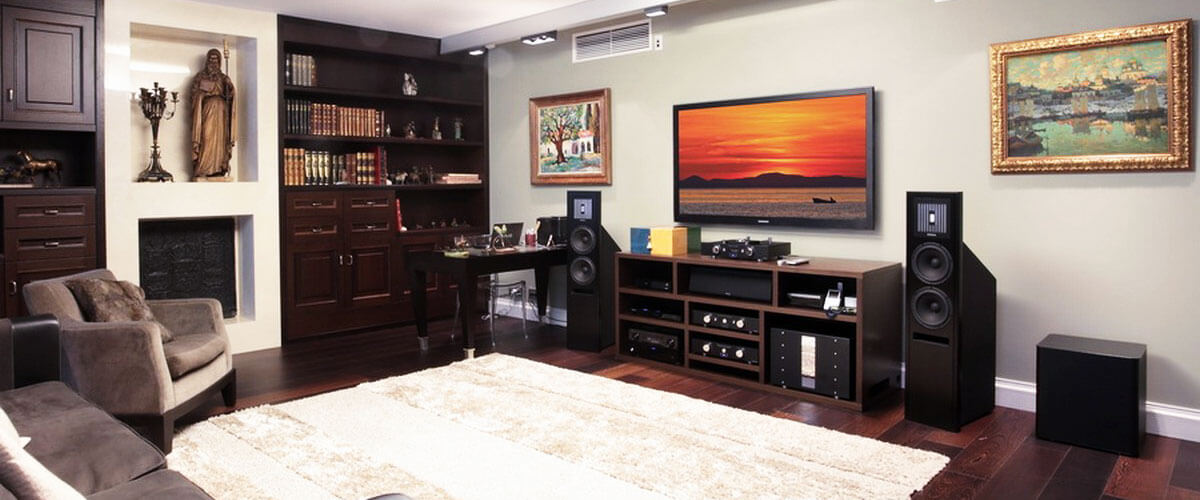
Firstly, let’s start with a brief explanation. This part is for those new to the AV receivers. Feel free to skip this part if you already know what makes Dolby Atmos so fancy. So, unlike conventional channel-based audio systems, Dolby Atmos employs object-based audio, enabling sound designers to position and move audio elements precisely within a three-dimensional space. Probably, it sounds way too complicated, right? To simplify matters, an Atmos AVR creates a more realistic and dynamic auditory experience for listeners.
How it differs from traditional surround sound
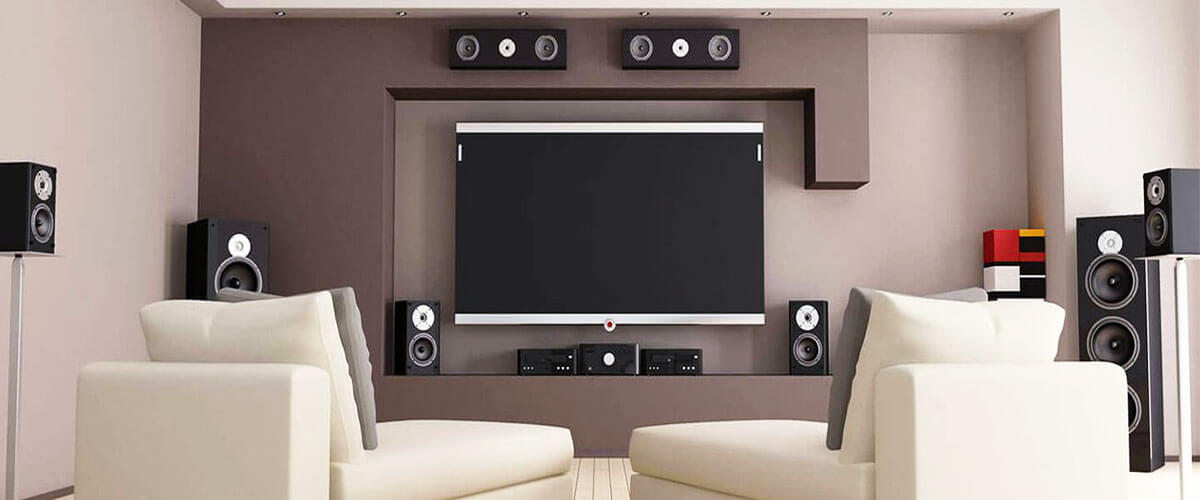
Indeed, a traditional surround sound is also very juicy and enjoyable. It relies on specific audio channels. But this limits the precision and flexibility of sound placement. In contrast, Dolby Atmos provides a versatile speaker setup, but that’s not all. There is a ‘little’ thing that takes it to another level. You see, the key features of Dolby Atmos include the addition of overhead sound channels.
Yep, here we are talking about AV receivers capable of recreating the same soundstage you get in cinemas. How cool is that? There is more! It has even ventured into music with Dolby Atmos Music, enhancing the production process in recording studios. Yet, I honestly don’t use my Atmos receivers for music. Even if you don’t have ceiling speakers or have difficulty installing them, the Dolby Atmos Height Virtualization technology is available. It brings a virtual Atmos experience to everyone. It is not the same quality as the real thing, but it still rocks.
Best Atmos receivers reviews
Marantz Cinema 50 – best overall

Marantz has a very loud name in the receiver industry. So, for those with experience with AV receivers, it is unsurprising that the Marantz Cinema 50 is the best Atmos receiver. For everyone else — brew the coffee or tea and enjoy the juicy facts about this beast. This AVR boasts a 9.4-channel amplifier with a formidable 110W per channel (8 ohms). It wouldn’t be a part of this review if it weren’t offered the Dolby Atmos and DTS:X.
Yet, hold on to the horses. Let’s get into more technical details first. This receiver is not just about the experience; it’s about the technical prowess. With 6 HDMI inputs supporting 8K (only 3), HDCP2.3, and HDMI Upscaling up to 8K, it is basically everything one needs to build a comprehensive home entertainment system. The Audyssey MultEQ XT32 works great for inexperienced people, and a user-friendly setup assistant greatly helps. Yet, I always prefer to tune it myself.
In turn, HEOS multi-room streaming, AirPlay 2, and various other smart features make it a versatile centerpiece. The Marantz Cinema 50 caters to the modern home with its comprehensive connectivity. From Ethernet ports to Wi-Fi, Bluetooth, and voice assistant compatibility with Alexa, Google Voice Assistant, and Apple HomePod, it seamlessly integrates into your smart home ecosystem.
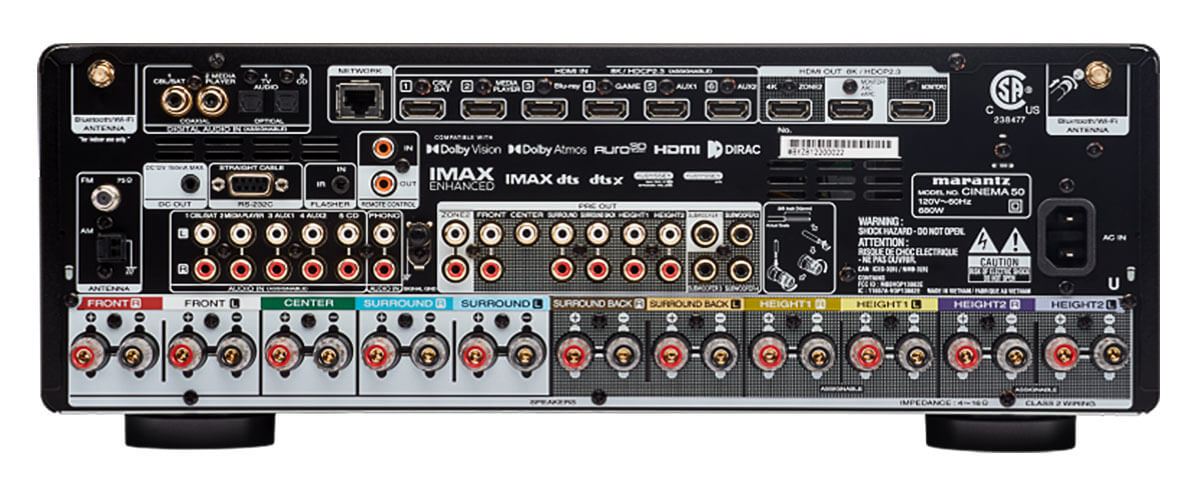
Finally, moving to the testing phase, I threw a lot of content at this receiver, including new Marvel movies, Blade Runner 2049, Ad Astra, and others. So, sharing the overall experience, every time a soundtrack played, my living room morphed into an otherworldly dimension. In addition, it mixes so amazingly well with dialogues and becomes even better with added sounds, echoes, and roars from a bustling city scene.
The ambient sounds of traffic, distant conversations, and the hum of urban life traversed the room, immersing us in the chaos. It gets even further with the explosions and ongoing shooting mixed with multiple ambient sounds from diverse directions. Regardless of what I threw at it, the Marantz Cinema 50’s processing power flawlessly executed the spatial placement of every sound element.
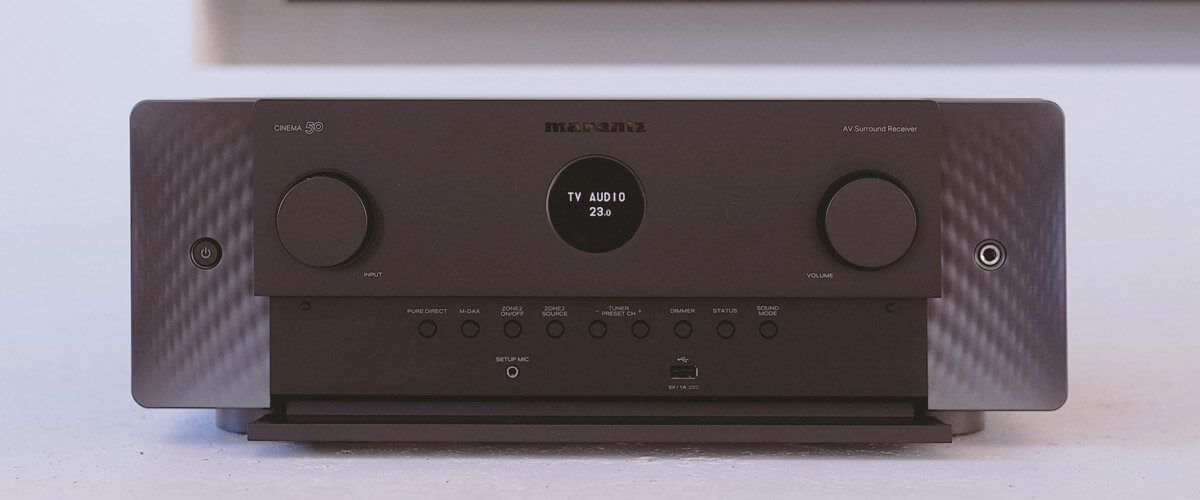
When you watch the movie supporting the Dolby Atmos, Cinema 50 turns the movie into a symphony of sound. That is why, in the realm of AV receivers, the Marantz Cinema 50 emerges as the best receiver for Dolby Atmos overall, balancing technical excellence with an unparalleled Dolby Atmos experience.
Key specs
- Channels: 9.4.
- Power output: 110W/8 Ohm, 150W/6 Ohm.
- HDMI inputs/outputs: 6/2.
- Video functions: 8K/60Hz, 4K/60Hz, 4K/120Hz, HDMI upscaling up to 8K.
- Bluetooth/Wi-Fi: yes/yes.
- Streaming services: AirPlay 2, Spotify, TuneIn, Deezer, Tidal, Netflix, Amazon Prime.
- Supports: HDMI ARC, HDMI eARC, HDMI CEC, HDCP2.3, HDR10+, Dolby Vision.
- Surround sound: DTS HD Master, DTS:X, DTS Neural:X, DTS Virtual:X, Dolby Atmos, Dolby TrueHD, Dolby Height Virtualization, Dolby Surround, MAX Enhanced, Auro-3D, 360 Reality Audio, MPEG H.
Pros
- I love its minimalistic looks and OLED display.
- Audyssey MultEQ XT32 tunes the receiver just fine.
- User-friendly setup assistant, very newbie-friendly.
- Movie-oriented and provides a truly unrivaled immersion in the events taking place on-screen.
Cons
- No front-mounted HDMI port.
- Requires additional attention to Heat dissipation.
Denon AVR-X2800H – budget
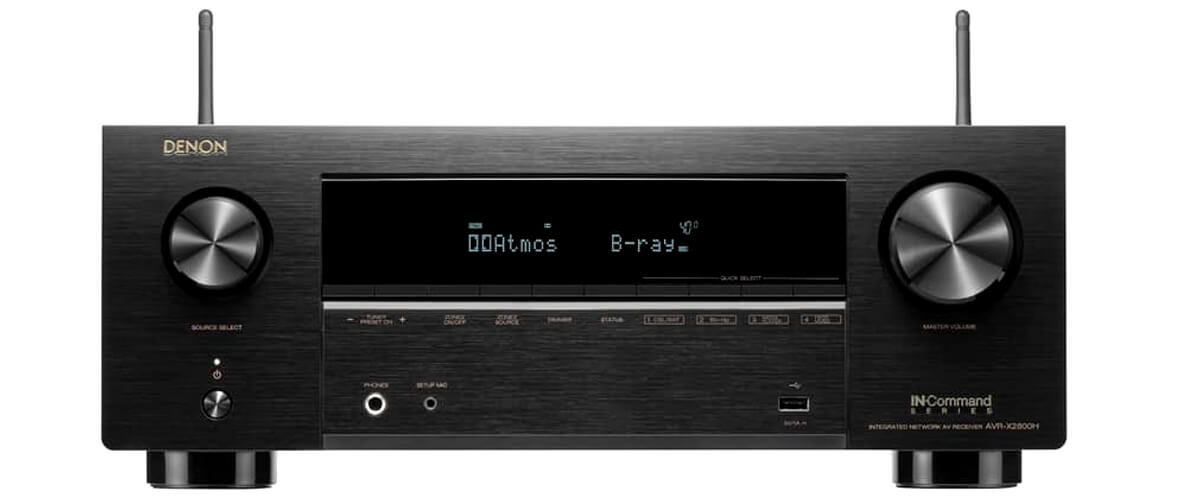
Surely, every bit of emotion one can get from experiencing the Dolby Atmos audio is worth every cent spent on it. But what if I say that there is a cheaper version? Yep, you heard me right — Denon AVR-X2800H is the option to opt for when willing to try Dolby Atmos and do it without hurting your family budget. So, what can one expect from the best budget Dolby Atmos receiver?
No compromising! Well, at least mostly. The receiver offers fewer channels and lesser power than the leader of this review (quite naturally) — 7.2 channels, 95 watts per channel. Not much, huh? However, for small to medium-sized rooms, this is more than enough.
Indeed, a cheap remote adds another grain of salt here, but the X2800H doesn’t compromise on connectivity. With 6 HDMI inputs supporting the latest standards, including HDCP2.3 and HDMI 2.1 features like 8K/60Hz and 4K/120Hz, it’s ready for the future of visual entertainment. HDR, Dolby Vision, and HLG support ensure a visually stunning experience.
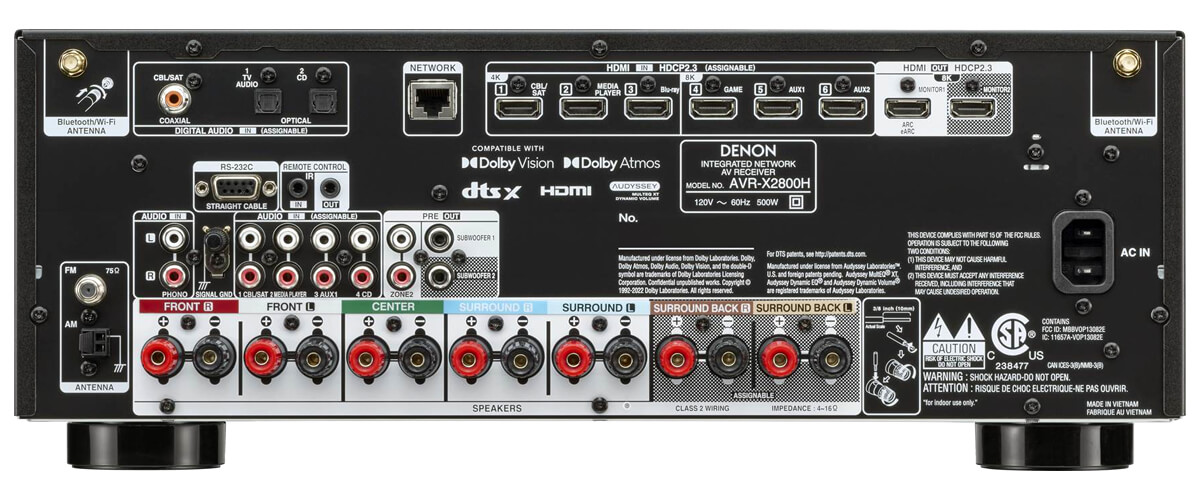
Additionally, the receiver boasts HEOS wireless multi-room technology. Alexa, Google Voice Assistant, and Apple HomePod compatibility offer convenient voice control. Streaming options like AirPlay 2, Spotify Connect, and Roon are also not a problem. This, combined with Ethernet ports, Wi-Fi, Bluetooth, and a dedicated app, makes the X2800H a very versatile product.
While watching movies, the AVR-X2800H showed itself quite well. Yes, it is not the limit of dreams but an excellent result for the budget category. I was satisfied with it.
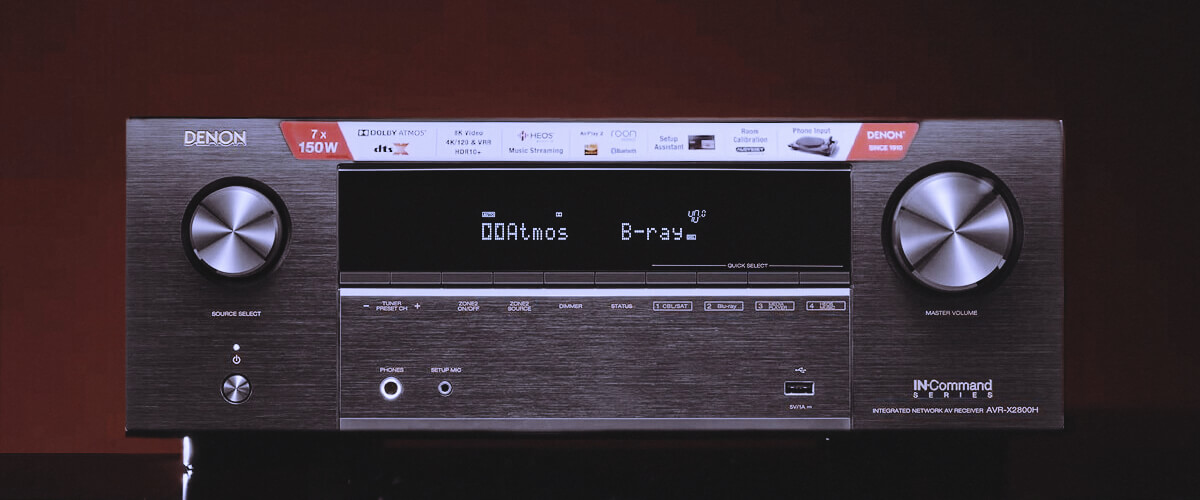
When conducting another test with this receiver, I thought, “Wow, am I getting 8K video supplemented with the Dolby Atmos sound for THAT cheap?” The truth is that, YES, you get it. Surely, having more amplified channels would take this emotion and experience even further. But when we talk about getting a budget AVR — the X2800H is the one to go with.
Key specs
- Channels: 7.2.
- Power output: 95W/8 Ohm, 125W/6 Ohm.
- HDMI inputs/outputs: 6/2.
- Video functions: 8K/60Hz, 4K/120Hz pass-through, upscaling to 8K.
- Bluetooth/Wi-Fi: yes/yes.
- Streaming services: AirPlay 2, Spotify, TuneIn, Deezer, Tidal, Netflix, Amazon Prime.
- Supports: HDMI ARC, HDMI eARC, HDMI CEC, HDCP2.3, HDR10+, HLG, Dolby Vision.
- Surround sound: DTS:X, DTS Neural:X, DTS Virtual:X, Dolby Atmos, Dolby Atmos Height Virtualization, DTS HD Master, Dolby TrueHD, Multichannel Stereo.
Pros
- Rich connectivity options.
- Supports of 8K content at 60Hz.
- It is energy efficient and pretty cool.
Cons
- Doesn’t provide the same level of amplification as higher-tier models.
- Cheap remote.
Onkyo TX-RZ50 – also great
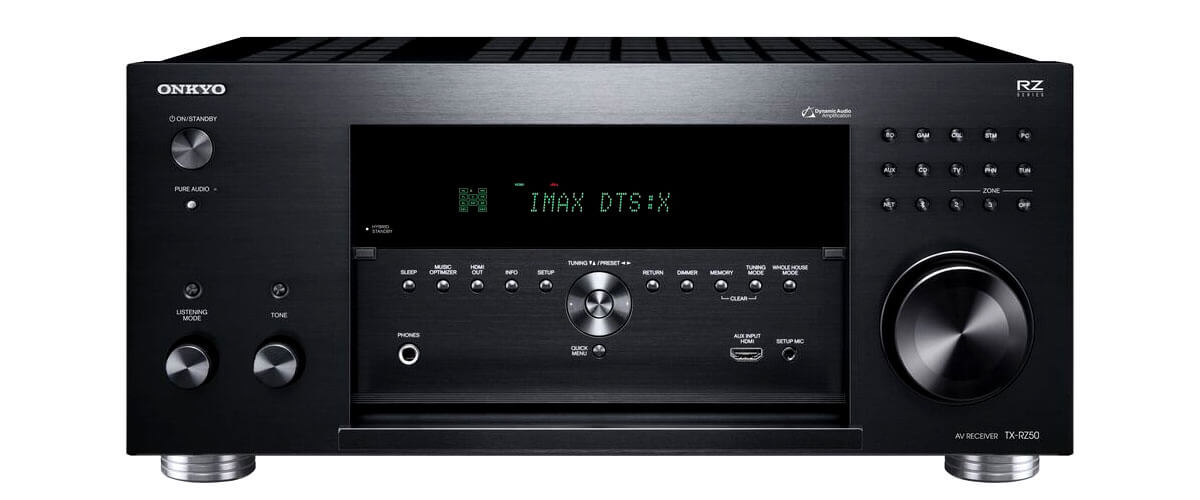
You can’t imagine how hard it was for me to choose the winner between the Marantz Cinema 50 and Onkyo TX-RZ50. This 9.2-channel Atmos ready receiver offers a stunning 120 watts per channel. Embarking on an auditory journey with the Onkyo TX-RZ50 was nothing short of a cinematic odyssey.
Talking about technical specifications and features, the receiver almost matches the Cinema 50, offering 8K/60p, HDR10+, and Dolby Vision. It also offers DTS:X, Dolby TrueHD, and DTS-HD Master Audio decoding. Talking about the Dolby Atmos — it allowed me to create a 5.2.4-channel testing setup.
The TX-RZ50 offers 7 HDMI inputs (1 front), 2 outputs (Main [eARC], Sub/Zone 2), 1 component, composite inputs, and others. I don’t want to give the complete list of connections here because it’s gonna turn into a dull sheet of text. The truth is that the TX-RZ50 offers a rich set of connectivity options without limiting you on what you want to connect.
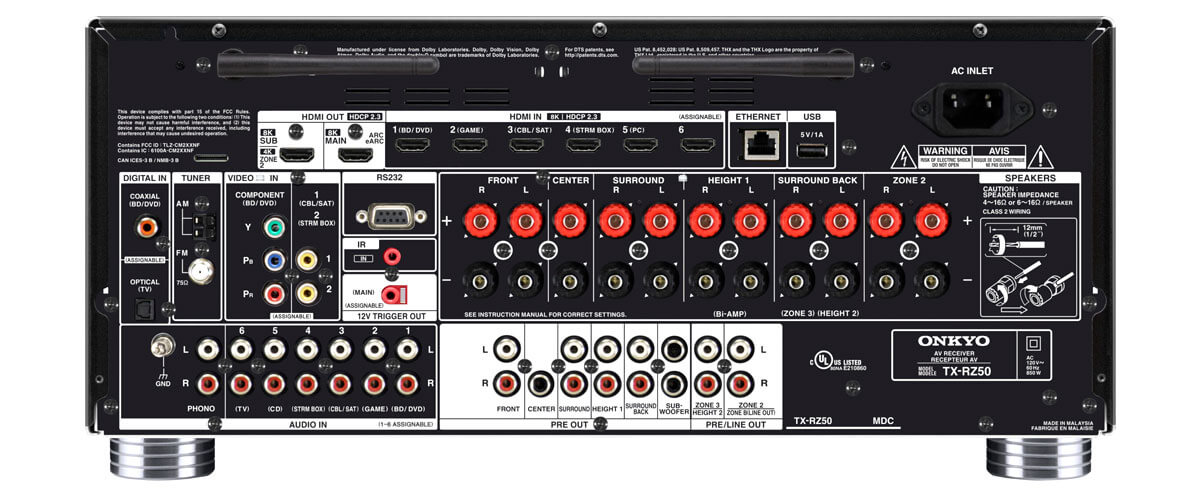
So, I started the testing with Gravity, a space-themed masterpiece. As the spacecraft traversed the screen, the TX-RZ50’s 120 W/Ch power output flawlessly delivered the sensation of floating through the cosmos. Dynamic power resonated, making the room vibrate with the powerful sound of Steven Price’s Oscar-winning soundtrack. With ±10 dB adjustments for bass and treble, the tone controls allowed fine-tuning for a personalized audio experience.
But the receiver truly shined in Dolby Atmos’s capability with The Dark Knight. The TX-RZ50’s ability to reproduce a wide frequency response from 5 Hz to 100 kHz allowed Hans Zimmer’s orchestral reverie to shine. Each instrument found its place in the audio canvas, from the deepest bass to the highest treble, enhancing my most loved Christopher Nolan’s Batman trilogy.
Onkyo is a pretty exciting brand, but it doesn’t have a strong name in the receiver industry. Even if the TX-RZ50 delivers stunning quality, the Marantz Cinema 50 still surpasses it, offering a much warmer sound. It also beats it in dynamic range and delivery.
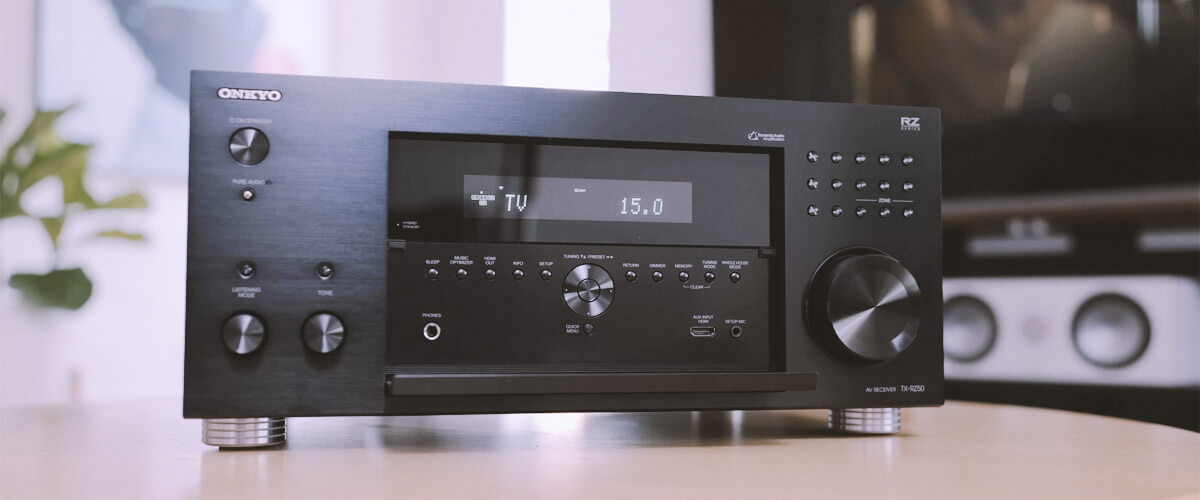
Nevertheless, the Onkyo TX-RZ50 proved its mettle. This unit can easily be your portal into the world of Dolby Atmos sound. The 9.2 channels, impressive power, and nuanced controls made every Dolby Atmos scenario a breathtaking experience. Yes, Onkyo is not the most popular or fancy brand, but their receivers offer quality sound and come packed full of features.
Key specs
- Channels: 9.2.
- Power output: 120W/8 Ohm.
- HDMI inputs/outputs: 7/2.
- Video functions: 8K/60Hz, 4K/60Hz, 4K/120Hz, HDMI upscaling up to 8K.
- Bluetooth/Wi-Fi: yes/yes.
- Streaming services: AirPlay 2, Spotify, TuneIn, Deezer, Tidal, Netflix, Amazon Prime.
- Supports: HDMI ARC, HDMI eARC, HDMI CEC, HDCP2.3, HDR10+, Dolby Vision.
- Surround sound: DTS HD Master, DTS:X, DTS Neural:X, Dolby Atmos, Dolby TrueHD, Dolby Height Virtualization, Dolby Surround, IMAX Enhanced.
Pros
- Adjustable tone control works amazingly well.
- Customizability, Dirac Live, and user-friendly interface.
- Comes packed with a rich set of features.
Cons
- Builds up a lot of heat when operating at maximum.
Yamaha RX-A8A – premium
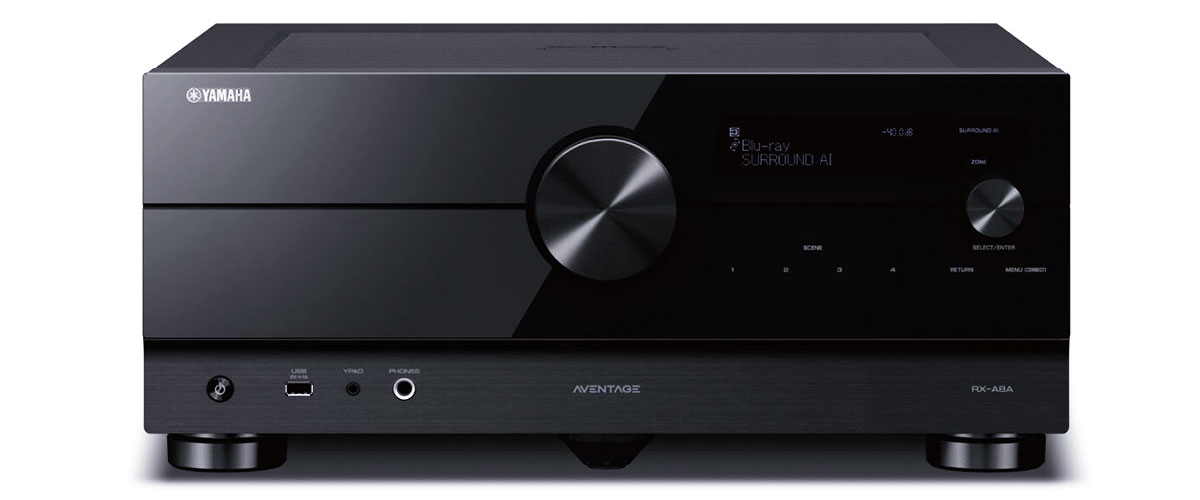
If you are reading these lines right now, you should know that I am happy you found my flow of thoughts and experience interesting. And, right now, I have the true high-end receiver — Yamaha RX-A8A. As a top-tier AVR, the RX-A8A boasts an impressive 11.2 channels. The 150W per channel power output, together with a high slew rate amplifier, ensures a dynamic and precise sound stage in any room.
At this level of technology, I can’t imagine why one may need more power for their home entertainment setups. But this is not the end. The RX-A8A stands out with its advanced surround sound processing capabilities. The inclusion of Surround: AI, Cinema DSP HD3, and 24 DSP programs is another reason to opt for it. Need more? This 11.2 Atmos receiver offers a Dialogue Lift and Virtual Presence Speaker feature, helping to create a more immersive and lifelike sound environment.
With the support of DTS:X and Auro 3D, the RX-A8A works with all modern audio technologies. Surely, it is a very well-packed model on the video side, too. It is equipped with HDMI eARC, HDMI upscaling up to 8K, and support for Dolby Vision and HDR 10+. The RX-A8A delivers on the video front as well. The ability to pass through 4K120AB and 8K60AB in the future proves this receiver. Sadly, I was disappointed by its upscaling capabilities — often, the quality and the picture felt slightly off.
Should I really note that it offers multiple and diverse connectivity options? Okay, I said it — in simple terms, if you need a connector, a Wi-Fi, modern Bluetooth protocol, or Zone 4 feature? You have it!
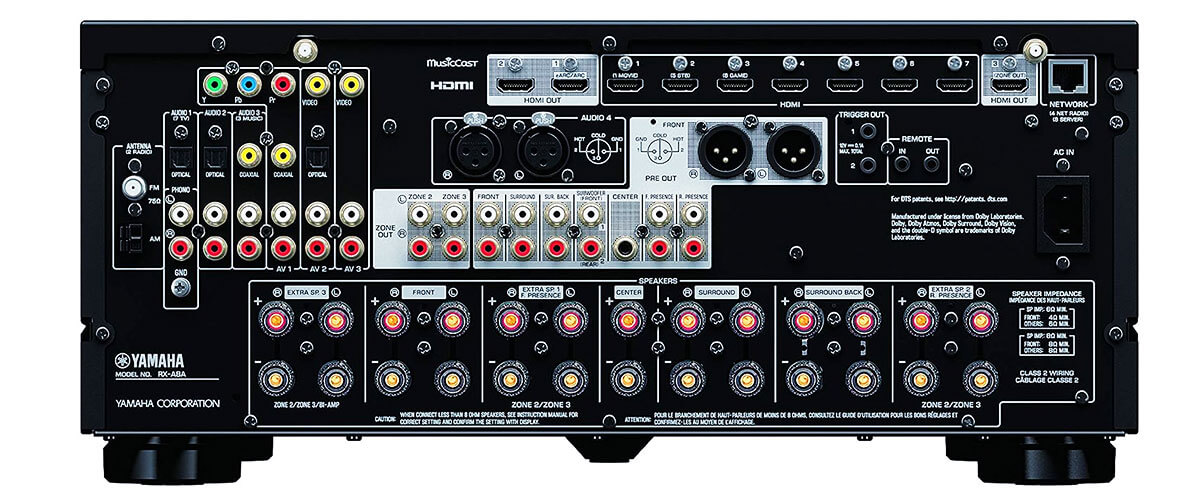
Premium products definitely deserve premium testing and content. Thus, the Dolby Atmos testing began with Celestial Symphony, a space-themed masterpiece. The RX-A8A’s precision in handling height channels is just another level. The emotion from the sound, the way it fills the room and spreads around the space, is amazing. Transitioning to an urban setting with Cityscape Echoes — same emotions there. No 9.2 Atmos receiver is capable of creating such a captivating three-dimensional soundscape.
Then I put it to the real test and watched Avengers: Endgame with my kids. As the monumental battles unfolded on the screen, the 11.2 channels of the RX-A8A seamlessly delivered the superheroic experience to our living room. Remember I was talking about power? The 150 watts of power output reverberated through the room, creating a dynamic soundscape that brought joy and excitement to my kiddos.
Transitioning to the comedic realm, my wife and I immersed ourselves in laughter with a classic comedy — Bridesmaids. The RX-A8A’s Surround:AI, Dolby Atmos, and Cinema DSP HD3 worked harmoniously, enhancing the comedic timing and spatial placement of every joke.
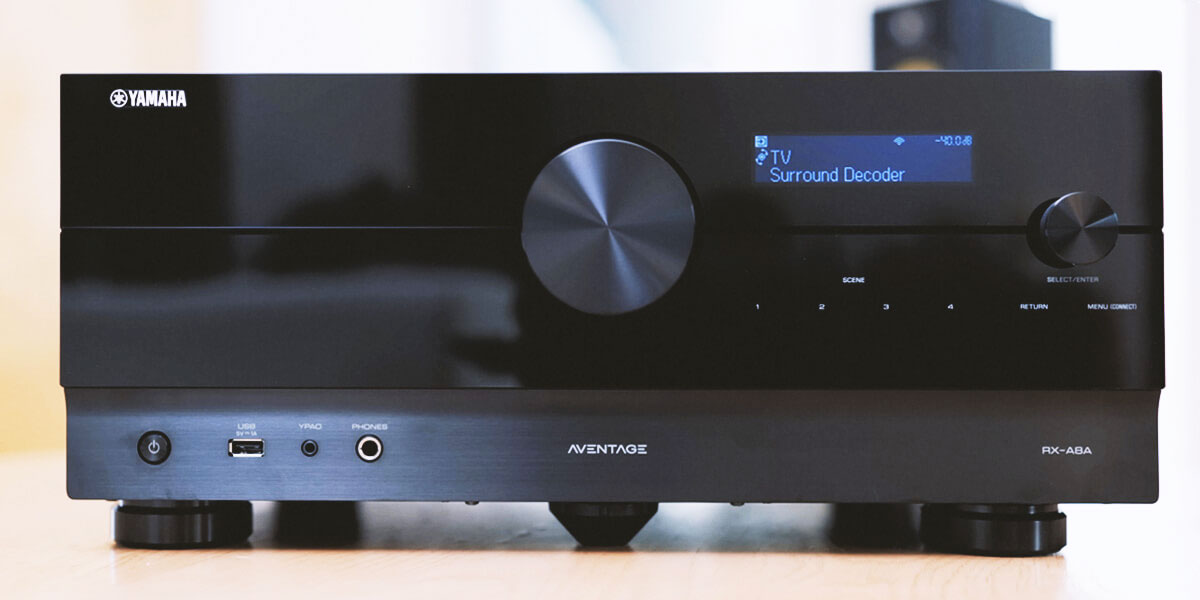
For a touch of romance, we delved into the world of La La Land. The RX-A8A’s audio prowess flawlessly captured the melodic symphony of the movie’s musical numbers. Thanks to Dolby Atmos and this receiver, the large-scale scenes of Los Angeles came to life, enveloping us in the romantic atmosphere of the movie. I can continue sharing more and more, but come on, this part has already become way too big.
So, I conclude that the Yamaha RX-A8A is like an alien from another planet, filled with modern technology. It is a competent unit. But here is a fly in the ointment: you need to know why you are buying this, and you have to build the whole home entertainment system around it. It just requires too significant an investment to get going, so I can’t put it to the top.
Key specs
- Channels: 11.2.
- Power output: 150W/8 Ohm.
- HDMI inputs/outputs: 7/3.
- Video functions: 8K/60Hz, 4K/120Hz, upscaling up to 8K.
- Bluetooth/Wi-Fi: yes/yes.
- Streaming services: AirPlay 2, Spotify, TuneIn, Deezer, Tidal, Netflix, Amazon Prime.
- Suppots: HDMI ARC, HDMI eARC, HDMI CEC, HDCP2.3, HDR10+, Dolby Vision.
- Surround sound: DTS:X, DTS Virtual:X, Dolby Atmos, DTS HD Master, Dolby TrueHD, Auro 3D.
Pros
- Outstanding sound quality.
- Delivers A LOT of power.
- Amazing standby consumption of only around 0.4 watts.
- Advanced networking capabilities and numerous additional functions.
- Components and chips of the highest quality.
Cons
- It is hard to set up and requires a lot of wire placing.
- Upscaling sometimes works really badly with no apparent reason for it.
FAQ
Do I need special speakers to experience Dolby Atmos at home?
What’s the difference between Dolby Atmos and DTS:X?
In contrast, DTS: X was originally designed for the common 7.1 sound systems, so it doesn’t experience such problems.

